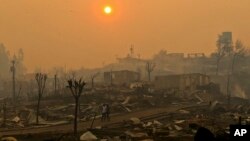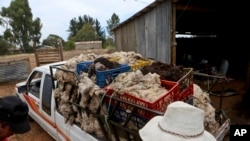The flames consumed everything on Sonia Diaz’s land: the machinery, supplies, even the shed for her sheep. But the 70-year-old artisan weaver still hopes to rise from the ashes.
Diaz is one of thousands of people who have lost most of their belongings and their livelihoods to some of the worst wildfires in Chile’s history. Besides farmers and ranchers, hundreds of small-scale winemakers, beekeepers and artisans have also lost everything.
With the flames seeming to be finally dying down — though they sometimes spread anew when winds whip up smoldering ash — survivors are looking at how to recover their livelihoods amid complaints by some that state aid is not enough given the extent of the devastation.
“I’m going to rise again through hard work, and hard work alone,’’ said Diaz, who had been assessing the damage to her town with other local artisans when she got a call warning her that the flames were spreading fast from the hills onto her land.
By the time she arrived, the fire had destroyed her supplies, including the wool she uses to make blankets, tapestries and shawls. Everything was burned but her home in Pumanque, 215 kilometers (130 miles) south of the capital, Santiago.
Help from around world
The ferocity of the blazes led President Michelle Bachelet to issue a state of emergency, deploy troops and seek international aid. Supertanker planes from the United States and Russia dumped thousands of gallons of water to assist local crews.
In all, more than 20,000 people, including firefighters and experts from more than a dozen countries, have battled the wildfires that Bachelet has called the worst forest disaster in Chile’s history. At least 11 deaths have been blamed on the fires.
The fires have consumed forests and entire towns. But many continue to show the same stoicism that has helped Chileans to recover from other natural disasters, including large earthquakes, tsunamis and volcanic eruptions.
Bachelet said Friday that the flames are no longer threatening residential areas for now and that her government is beginning to hand out money and food to the Chileans who have been hit hardest by the fires.
“The emergency situation is still ongoing, so it’s important to not drop our guard,’’ Bachelet said.
Damage not quantified
So far, the government has spent about $330 million to control the emergency and is helping small-scale farmers rebuild their homes and lands, said Finance Minister Rodrigo Valdes. The full extent of the damage has yet to be quantified.
An estimated 80 families that made a living from beekeeping lost their livelihoods in the area near the city of Cauquenes, about 350 kilometers (220 miles) south of Santiago. About 63 million bees died in the area and some 240 million bees are at high risk, said forestry engineer and beekeeper consultant Carlos Correa.
Beekeeper Jorge Andrade complained that the $1,500 government aid that he will get for losing it all, “is nothing,’’ and will only help him recover a small fraction of his hundreds of beehives.










